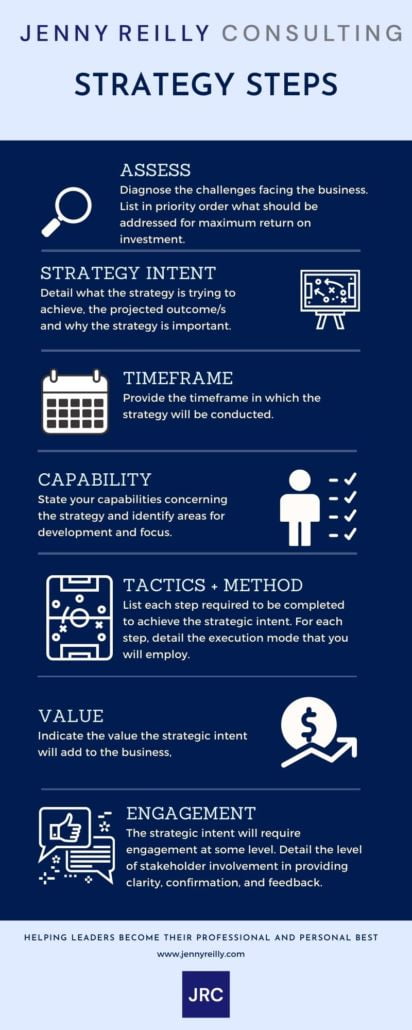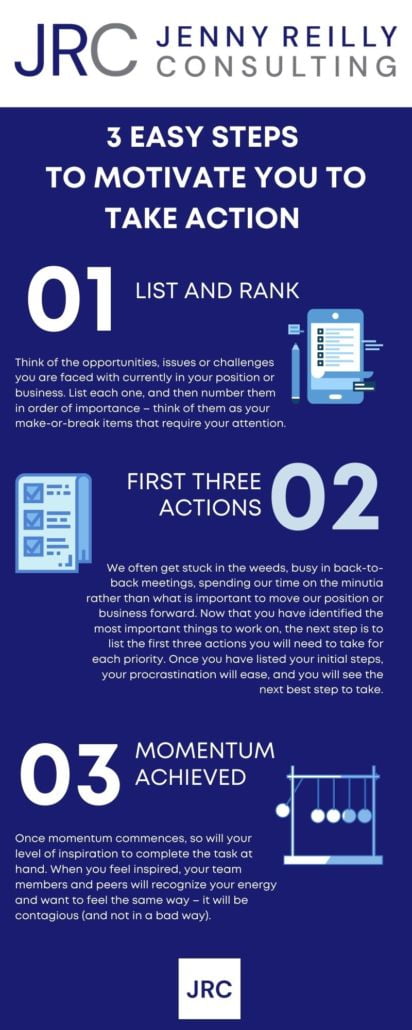Quarter 3 – Refine Your Strategic Intent
Strategic Intent
What challenges, opportunities or issues should you professionally be focusing on this Quarter?
Every Quarter I block a day off to work on my business. I structure time to do a review of the past Quarter. I then assess the following categories to help determine the top three areas that I should strategically focus on for the upcoming Quarter:
Business Strategy Defined for the Quarter – review, check if still relevant and a priority, and determine if the strategy needs to be tweaked or changed.
Money + Business Finances – evaluate the past Quarter’s financial performance and update the future Quarter’s projections. Assess costs that could be reduced, determine if there are any opportunities to increase profits.
Marketing – review ROI on marketing expenditure, assess distribution channels for improvements, determine any new implementations and digital marketing strategies for next Quarter. Review website content and assess if any changes, updates or additions are needed.
Sales – review the sales process and determine any areas for improving customer focus and service. Develop your revised sales strategy for next Quarter.
Employees – connect with employees to discuss satisfaction, ideas for improvement and overall feedback on the business/unit.
Operations – assess how the business can be leaner and more efficient, focus on reducing costs, and consider ways in which processes can be improved to increase output.
Technology – review technology expenditure in the last Quarter. Evaluate software being used, and determine better ways to utilize it for maximum productivity and profitability.
“Designing a winning strategy is the art of asking questions, experimenting and then constantly renewing the thinking process by questioning the answers.”
~ Constantinos Markides ~
Professor of Strategic Leadership at London Business School

After prioritizing areas that you want to focus on, follow the next three steps:
Step 1. Articulate your top three Q3 strategies.
Step 2. Define the capabilities, gaps, or potential threats that may stand in the way of achieving your strategy.
Step 3. Keep it simple, detail steps that you will be required to take, by when and by whom through the implementation stage.
Capabilities
Your capabilities, skills, knowledge and competencies enable you to fulfill your strategy. Your capabilities can be compiled under your reputation, people, technology, assets and finances.
The following questions will help provide focus on areas that need concentration and development:
- Do you have a poor, satisfactory, good, or great reputation?
- Do you have a loyal client/customer base?
- Do you have a strong, recognizable brand?
- Do you have knowledgeable, engaged, experienced and skilled people?
- Do you utilize technology that meets your expectations to help you grow and scale in your position or business?
- Do you have sufficient financial reserves to cover six months of expenses in case of emergencies?
As a result of answering the above questions, what areas should you concentrate on to improve in Q3?
For each area identified, estimate how much time you should spend working on improvements, and block off the required time in your schedule over the upcoming three months.
Action + Execution
“Strategy is easy – the day-to-day and month-to-month decisions required to manage a business – are hard.”
~ Arthur Rock ~
Strategy execution is difficult to facilitate effectively without some of the following core components:
- Structure: structure enables employees to understand their role and how their core tasks fit into the big picture.
- Processes + Systems: provide clear and transparent information and a map of how to do things and in what order.
- People: your people’s skillsets and mindsets are key to having effective processes, procedures, and structures in place.
- Incentives: rewards enable motivation, establish metrics and key performance indicators to follow in the delivery of strategies.
Your leadership style and behaviour set the tone for your business/unit. When leading a strategic intent, your authenticity is instilled by what you say, what you do, and how you do it. Strategic leadership is based on decisiveness on how to move forward founded on due diligence. Analysis of the facts and stakeholder input provides you with a direction forward and negates personal perceptions getting in the way and lending to errors of judgement. Being decisive in your strategy execution enables you a path to follow, and at the same time, pivot or adjust as new information is presented or circumstances change.
Executing tasks requires time to find the time you have to block off uninterrupted periods in your schedule to enable focus and efficiencies. Not having enough time to execute on a strategic intent is an excuse. Make the time, prioritize your schedule and be diligent in following through.
What is your strategic leadership capacity?
Sound knowledge of strategy is critical for all in leadership positions. The importance of identifying, analyzing complex business decisions, crafting strategic intent statements, and being confident in making informed decisions cannot be understated.
Your strategic leadership capacity can be developed, and the best way to start this process is to gain a more comprehensive understanding of all management and strategy areas. Strategy needs to be continually reviewed in our evolving, dynamic and ever-changing environment. Integrating different viewpoints when conducting your analysis of an issue, evaluating those viewpoints and selecting the most appropriate course of action will enable you to develop into a strong strategic leader.
DO YOU WANT TO BE A STRATEGIC LEADER?
Strategic leaders are attentive and listen carefully to external perceptions and internal stories from colleagues on their business. Checking in on internal and external feedback can provide a bountiful of information that can be extremely useful from a strategic standpoint. If there are patterns in the stories, there are often multiple areas that can be pinpointed that will require strategic leadership attention.
Questions you could ask stakeholders:
- If you had to describe the current business strategies through an internal story that shone in either a positive or negative light, what would it be?
- Are there any reoccurring problematic issues that are occurring in the business? Can you define them and provide your feedback on how they could be addressed?
Questions for you to consider in Q3:
- In comparison to the current reputation of your business, can you provide a description of where you would prefer it too ideally be?
- What are the normal processes you go through when making significant strategic decisions that will affect the bottom line?
- Think about the internal business culture and the ways in which people behave and are treated within the organization. What are three things that you could be doing in Q3 to improve the business culture?
Tips for leading strategically include:
- Consider internal and external data factors in the execution of your decisions.
- Be mindful of the complexity and ambiguity around strategic issues, and ensure communication is transparent when factors are not straightforward.
- Integrate ideas from cross-functional areas in your business to ensure diverse positions are considered.
- Don’t micromanage; in fact, take a step back and allow others to manage their responsibilities and deliverables.
We can help you with your professional development or provide tailored executive coaching that can help support your leadership or your leadership team, please reach out to askme@jennyreilly.com to schedule a convenient time for a complimentary strategy session.
Get your leadership strategies and tactics in my monthly newsletter, sign up here to subscribe.










